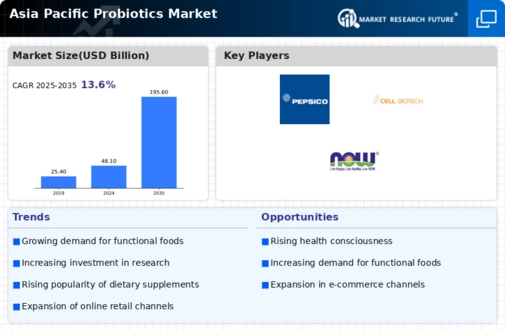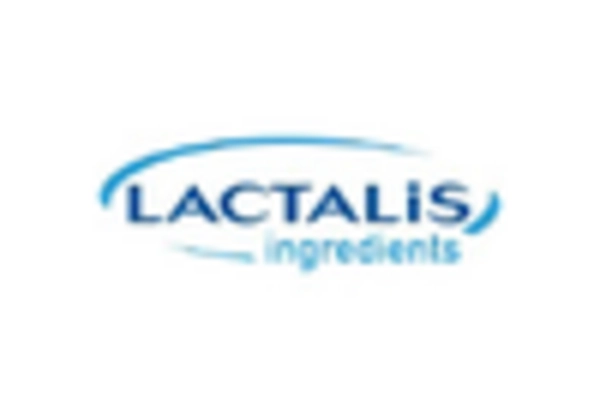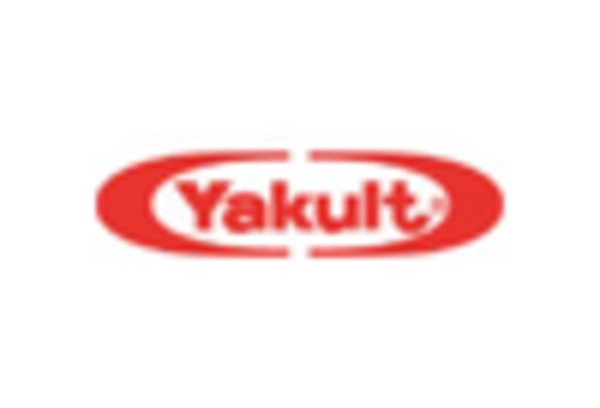Growing Demand for Functional Foods
The Asia Pacific Probiotics Market is experiencing a notable surge in demand for functional foods, driven by an increasing consumer awareness regarding health benefits. As individuals become more health-conscious, they are actively seeking products that offer additional nutritional value. Probiotics, known for their positive effects on gut health and overall well-being, are increasingly incorporated into various food and beverage products. According to recent data, the functional food market in the Asia Pacific region is projected to grow at a compound annual growth rate of approximately 8% over the next five years. This trend indicates a robust opportunity for the probiotics sector, as manufacturers strive to meet the evolving preferences of health-oriented consumers.
Rising Incidence of Digestive Disorders
The prevalence of digestive disorders in the Asia Pacific region is contributing significantly to the growth of the Asia Pacific Probiotics Market. Conditions such as irritable bowel syndrome, constipation, and diarrhea are becoming increasingly common, prompting consumers to seek effective solutions. Probiotics are recognized for their ability to alleviate these issues by promoting a balanced gut microbiome. Recent statistics suggest that digestive disorders affect nearly 20% of the population in some Asia Pacific countries, creating a substantial market for probiotic products. As healthcare professionals recommend probiotics as a preventive and therapeutic measure, the demand for these products is likely to escalate, further driving market growth.
Regulatory Support for Probiotic Products
Regulatory frameworks in the Asia Pacific region are evolving to support the growth of the probiotics sector, thereby positively impacting the Asia Pacific Probiotics Market. Governments are increasingly recognizing the health benefits of probiotics and are implementing guidelines to ensure product safety and efficacy. This regulatory support not only fosters consumer confidence but also encourages manufacturers to invest in high-quality probiotic products. Recent initiatives by health authorities to promote the consumption of probiotics as part of a balanced diet are likely to stimulate market growth. As regulations become more favorable, the industry is expected to witness an influx of innovative probiotic products that meet consumer demands.
Growing E-commerce and Online Retail Channels
The proliferation of e-commerce and online retail channels is transforming the distribution landscape of the Asia Pacific Probiotics Market. Consumers are increasingly turning to online platforms for convenience and access to a broader range of probiotic products. This shift is particularly pronounced among younger demographics who prefer the ease of online shopping. Data indicates that online sales of health supplements, including probiotics, are projected to grow by over 20% in the coming years. As e-commerce continues to expand, it presents a significant opportunity for probiotic brands to reach a wider audience and enhance their market presence.
Increased Investment in Research and Development
Investment in research and development within the Asia Pacific Probiotics Market is fostering innovation and expanding product offerings. Companies are increasingly focusing on scientific studies to validate the health benefits of probiotics, leading to the development of new strains and formulations. This emphasis on R&D is crucial, as it not only enhances product efficacy but also builds consumer trust. Recent reports indicate that the R&D expenditure in the probiotics sector is expected to rise by 15% annually, reflecting the industry's commitment to advancing knowledge and product quality. As a result, consumers are likely to encounter a wider array of probiotic products that cater to specific health needs.

















Leave a Comment